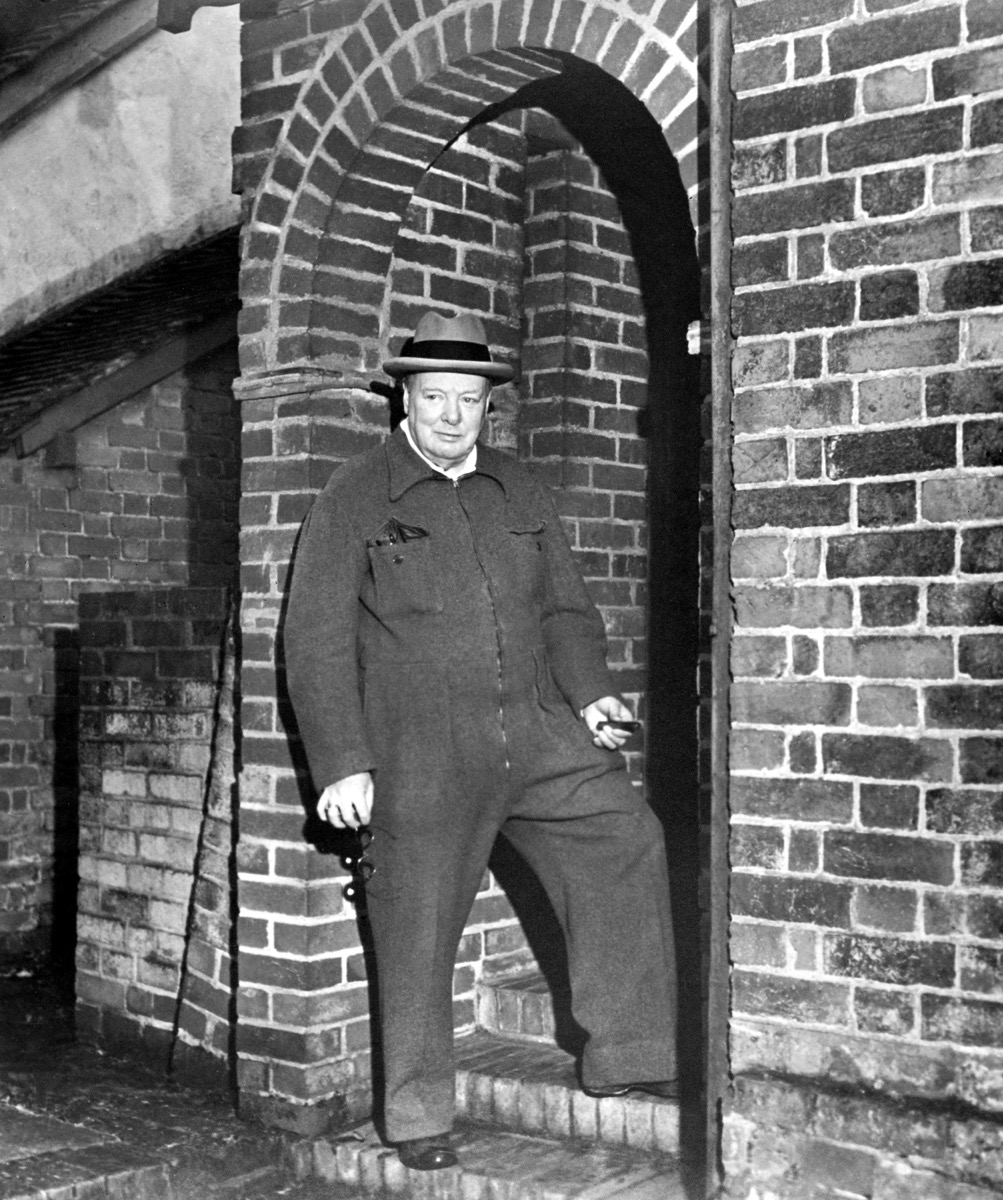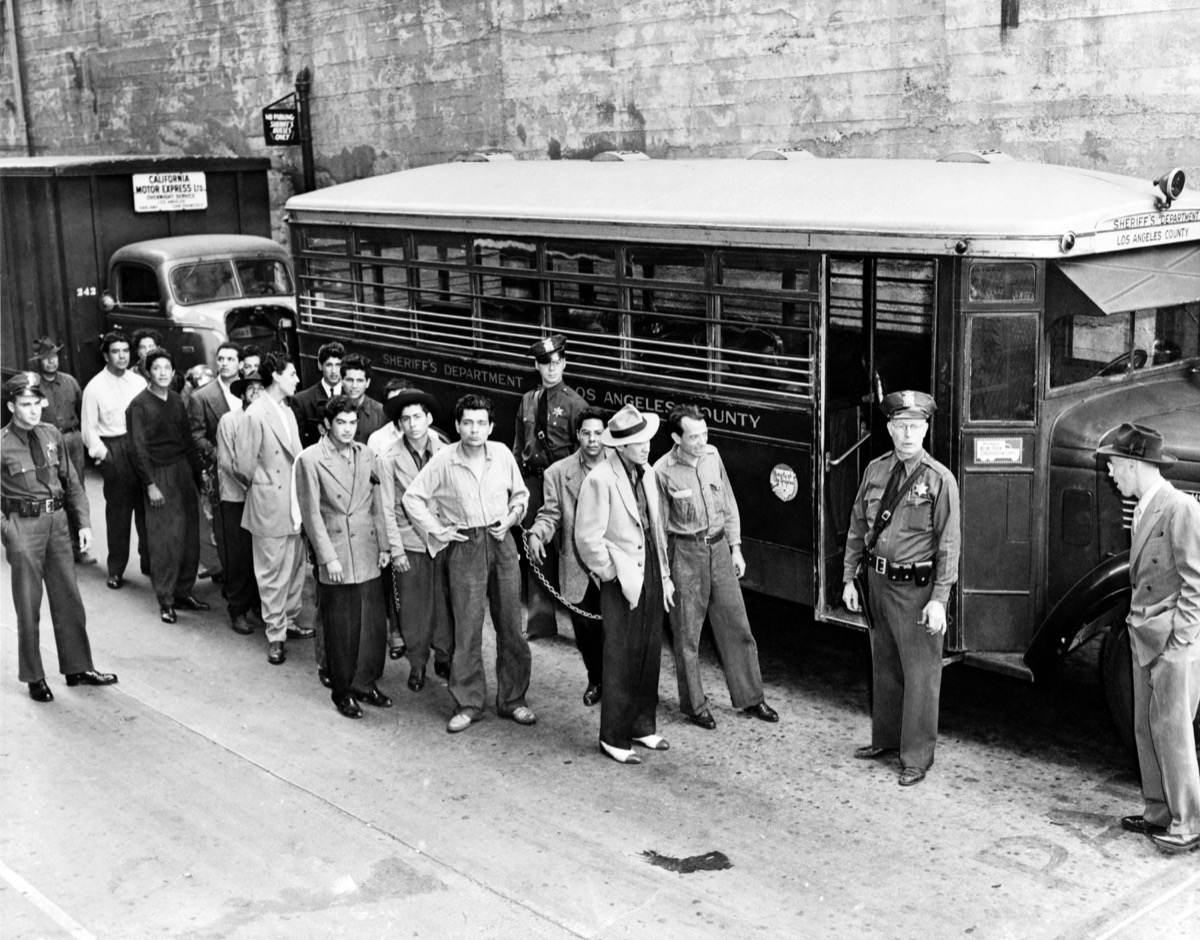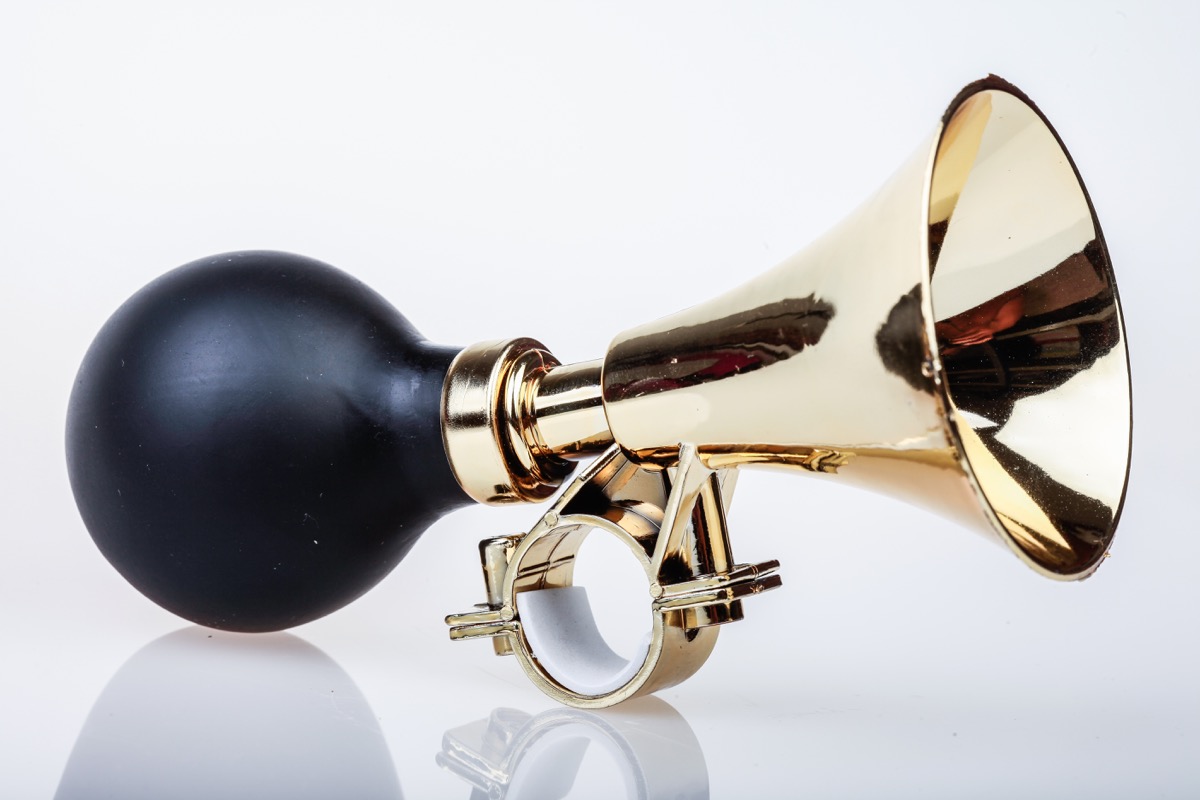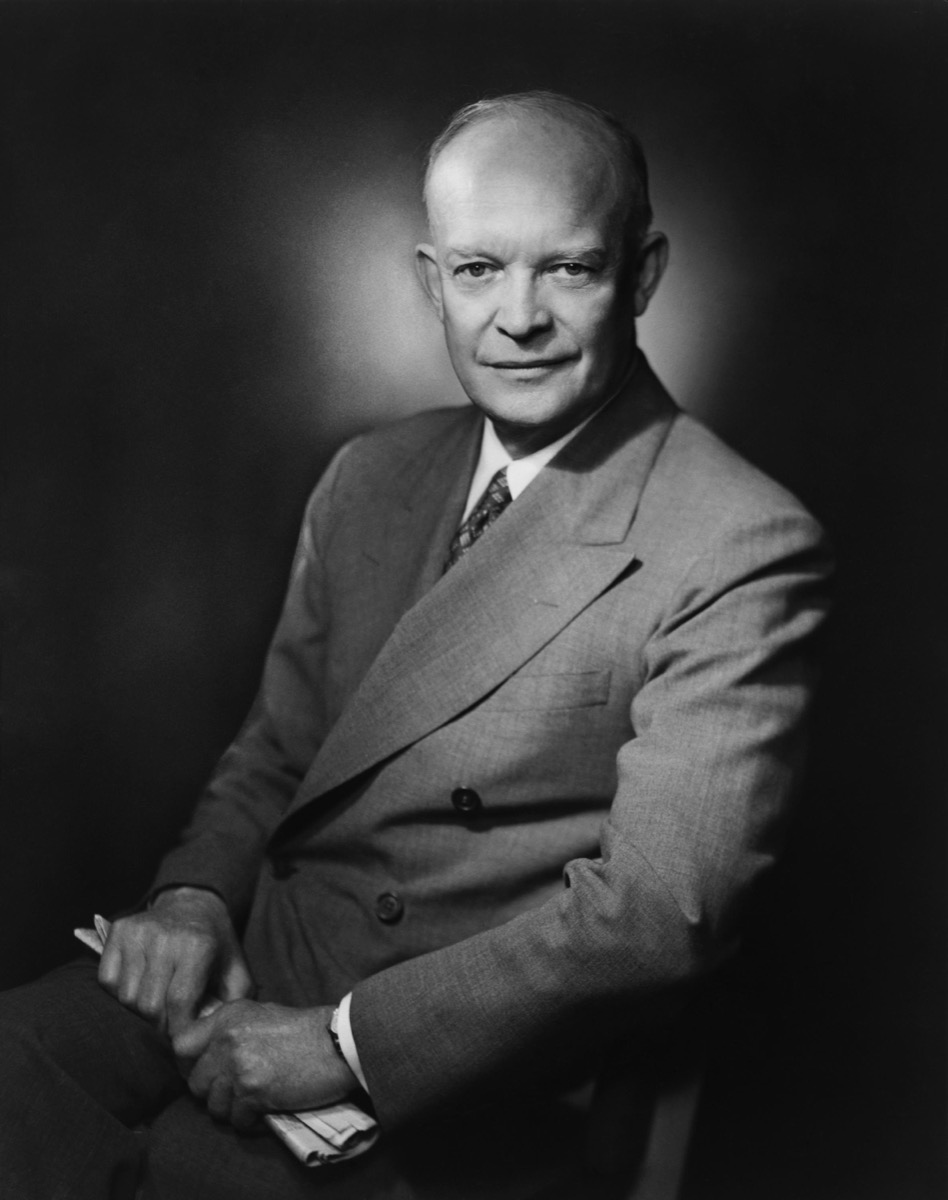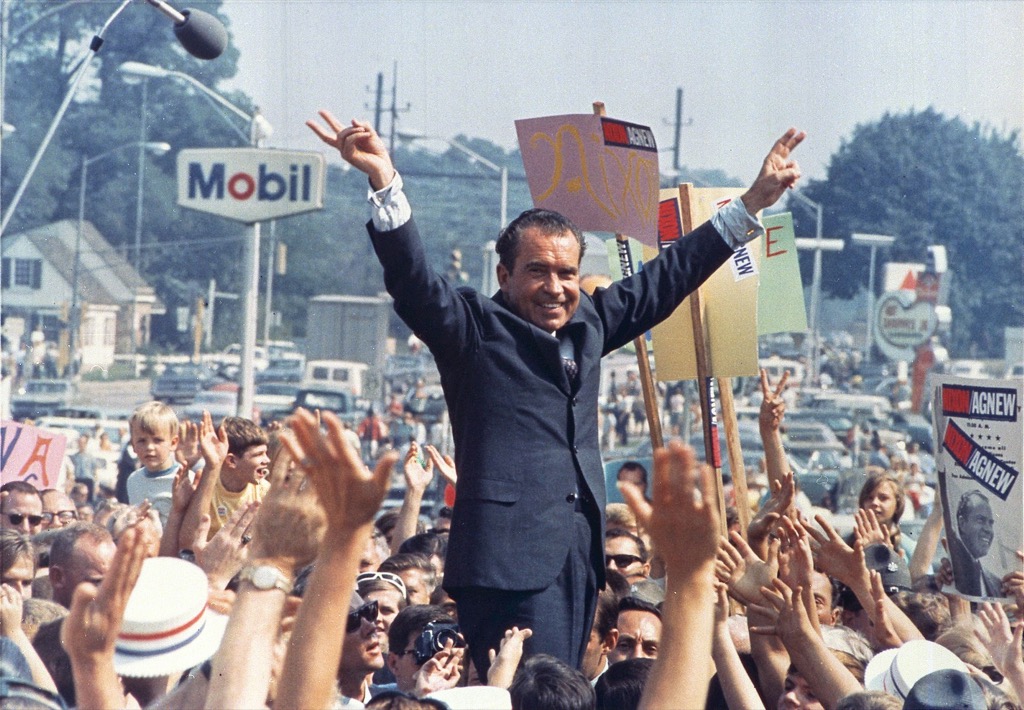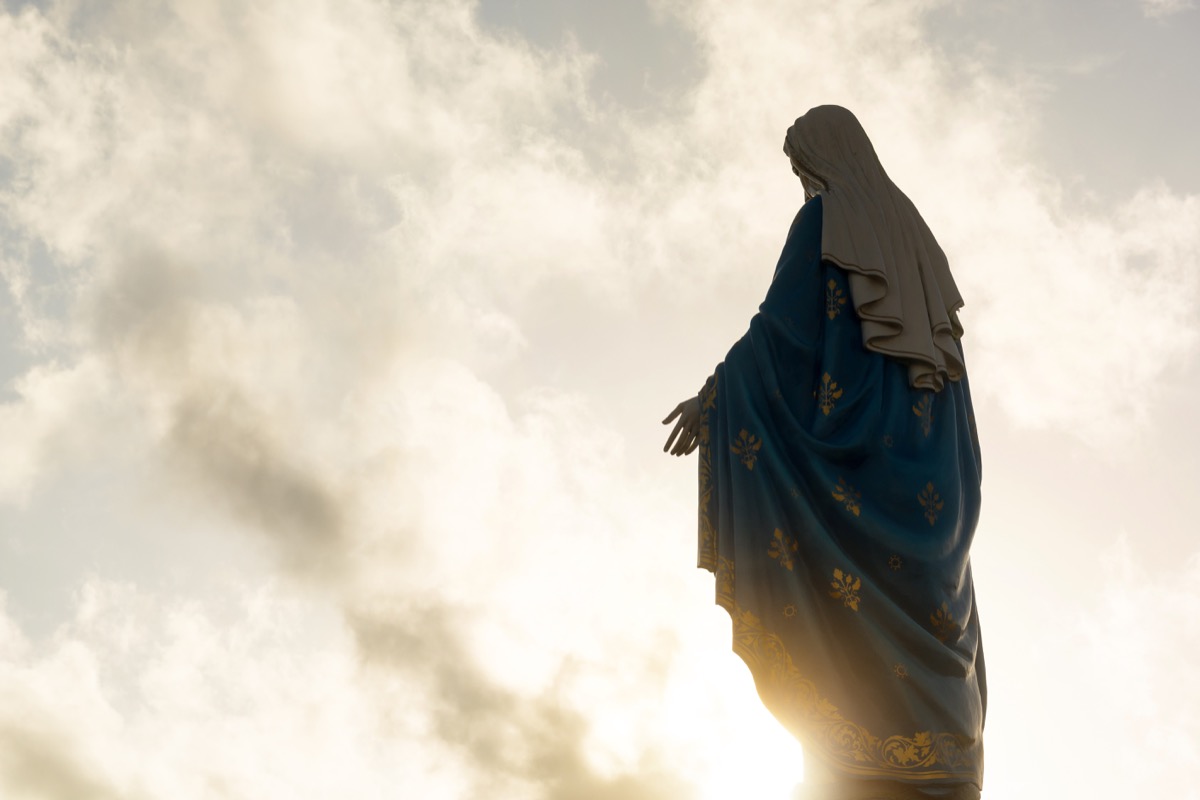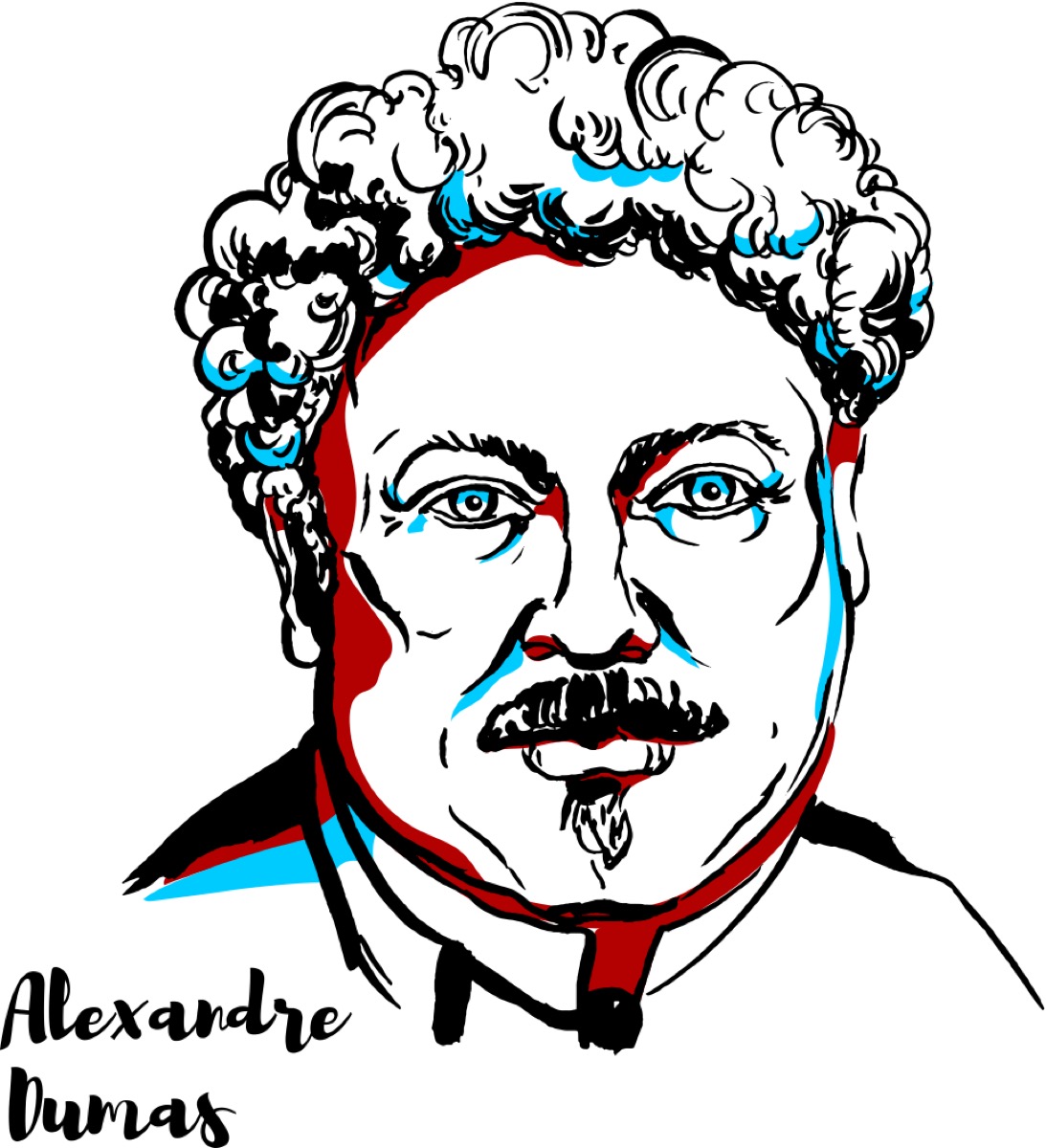But these important historical events are known far and wide—and sometimes you want to discover the nuttiest thing that happened the year you were born. What was the most bizarre crime? Who made the wildest discovery? And which ridiculous fad was the entire world obsessed with? To help you learn those bits of trivia, we’ve rounded up the most head-scratching moments from 1940 to 2000. And for more incredible history, check out The Biggest Cultural Event the Year You Were Born. What started as a French teenager taking his dog for a walk in the woods ended up being one of the most important archaeological discoveries of the century. As it turns out, the boy, Marcel Ravidat, and his pet stumbled upon the Lascaux Cave paintings, which had been hidden for 17,000 years in the Vézère valley (that’s a photo of them, above). In 1979, the cave became a UNESCO World Heritage site. Fashion trends come and go, but one 1941 getup is particularly notable because of its dark origins. “Siren suits” were designed so that people would have something quick and protective to throw on if they had to run to seek shelter during an air raid. Winston Churchill was a huge fan of these one-piece rompers (that’s him wearing one, above), but they came in women’s varieties too, featuring different patterns and cinched waists. And for more interesting tidbits from the past, check out the 100 Slang Terms From the 20th Century No One Uses Anymore. Though helicopters had been around for awhile by 1942, they were primarily used for short distances. That’s why, when a helicopter made the first American cross-country flight in the spring of that year, it made major headlines. The chopper also ascended to a height of 5,000 feet—another American record. And for more interesting facts, This Is the Dirtiest State in the U.S. June 1943 saw the outbreak of the so-called “Zoot Suit Riots” in Los Angeles, California—a series of racially-charged conflicts between white servicemen and Latino youths. The riots got their name because some of the kids involved wore baggy zoot suits that were fashionable at the time. “Mobs of U.S. servicemen took to the streets and began attacking Latinos and stripping them of their suits, leaving them bloodied and half-naked on the sidewalk,” according to the History Channel. “Local police officers often watched from the sidelines, then arrested the victims of the beatings.” A March 1944 alarm clock sale at a Chicago department store made headlines when approximately 2,500 people crammed into the store to purchase one of the 1,500 Westclox Warlarms on offer. In the process, three women fainted, several clerks were trampled, and four showcase windows were shattered. The police were called to the scene to restrain the alarm-clock-loving crowd. And for more fun information delivered straight to your inbox, sign up for our daily newsletter. In an attempt to temper contagious diseases like mumps and chickenpox, one New York school district installed germicidal lamps. The idea was that the ultraviolet light emitted from the light fixtures would kill any germs and help stop the spread of dangerous illnesses. (Unfortunately, it didn’t work.) In December of 1946, a man posing as a detective approached a 19-year-old woman and asked her to take a photo of another woman in the Times Square subway station. The woman did as she was told, but the weird-looking “camera” was actually a concealed gun, and when she took the picture, she actually shot the woman. The target was the ex-wife of a gangster and the detective was—you guessed it—that gangster who found someone else to do his dirty work. One morning in 1947, a bus driver from the Bronx was fed up with his job, so he decided to take his bus on a 1,300-mile detour to Florida. He disappeared for two weeks before turning himself in because he ran out of money. Though the driver faced indictment for grand larceny, he was also hailed a local hero and his colleagues hosted a dance to raise money for his legal fees. Luckily though, the charges were later dropped. When a California man grew frustrated because people driving cars seemed to have all the power over pedestrians, he decided to take matters into his own hands. Hilton Tupman, a Los Angeles car dealer, created a horn for pedestrians so they could let drivers know when they were out of line. He put the prototype together used surplus war materials. The sound of the horn could be heard from a mile away. In 1949, J. Edgar Hoover, the director of the FBI, gave former child actor Shirley Temple an unusual gift. On the day of the presidential inauguration, Hoover invited the then-21-year-old woman out on to his office balcony to watch the parade. (The two had known each other since she was a kid and received kidnapping and death threats.) While they were out there, he presented her with a tear gas gun that looked like a fountain pen. Residents of a village in Germany were thoroughly confused when several local chickens spontaneously exploded. As it turns out, the chickens had gotten into some carbide previously discarded by British troops. After drinking water, the carbide generated gas in their stomachs that resulted in the explosions. One summer night, a group of professors from Texas Technological College (now Texas Tech University) were sitting on the front lawn of their colleague’s house in Lubbock, Texas. They claim they saw an arc of green lights move through the sky overhead. Other people in the city witnessed the same phenomenon over the next few weeks and many suspected it was a UFO. In April 1952, Life magazine dubbed the so-called “Lubbock Lights” one of the top-10 most formidable UFO cases. For five days in December 1952, a thick fog blanketed London, killing more than 12,000 people and hospitalizing another 150,000. The fog was the result of a cold spell, which led to more and more Londoners turning on their coal fireplaces. Because of it, visibility was so poor that some residents reported hardly being able to see their feet. The ordeal led to the Clean Air Act of 1956, which restricted the burning of coal in urban areas. Dwight D. Eisenhower was inaugurated as president in January of 1953. In addition to the usual pomp and circumstance, Eisenhower was lassoed by Montie Montana—a rodeo cowboy stuntman. But it wasn’t an impromptu lasso: Montana first got permission from the Secret Service. On Christmas night of 1954, rhythm and blues singer Johnny Ace was taking a break backstage during a dance in Houston, Texas, when he came across a .22 caliber revolver. Another performer tried to take a bullet out of the gun, but Ace argued that nothing would happen if he pulled the trigger. Unfortunately, he was wrong, and the 25-year-old died instantly when he shot himself in the temple. George Orwell’s book Animal Farm made waves as soon as it was published in 1945. A decade later, a production company in the United Kingdom created an animated film adaptation of the famous book. Concerned that the public might be too influenced by the story, the CIA decided to get into the movie business and changed the ending of the film—taking out the humans and leaving only the pigs. On the fourth of July in Unionville, Maryland, in 1956, a world record was set for the greatest one-minute rainfall: An impressive 1.23 inches of precipitation fell in just 60 seconds. One resident told the Monthly Weather Review in August of that year that the rain was “so heavy that new gutters and downspouts installed on a warehouse were almost useless as water poured off the roof like the ‘Niagara Falls.’“ae0fcc31ae342fd3a1346ebb1f342fcb In August 1957, the Philadelphia Phillies were playing the New York Giants when Phillies’ Hall of Famer Richie Ashburn hit a foul ball that hit a woman in the stands in the face, breaking her nose. Then, as they were carrying her out on a stretcher, Ashburn hit a second foul ball which struck the same woman, this time breaking a bone in her knee. In 1958, Walt Disney released a nature documentary called White Wilderness. It famously included a segment featuring lemmings and their supposed tendency to commit mass suicide. One scene showed the small rodents jumping off a cliff into the ocean during migration. However, it was entirely fabricated: Turns out, lemmings do not commit mass suicide; instead, Disney filmmakers staged the whole thing. Young people in the 1950s had some interesting ways of keeping themselves entertained, including stuffing people into phone booths. In the spring of 1959, a group of 25 male students in Durban, South Africa, all crammed into a phone booth in the hopes of landing in the Guinness Book of World Records. The fad made its way to the United States but died out by the end of the year. Frankly, it’s really no stranger than planking. Back in 1960, students at the Massachusetts Insititute of Technology decided to amuse themselves during the cold winter months by creating a giant icicle that stretched down the side of the Baker House building. Stemming from room 419, the frozen stream of water was four-stories high when it was removed. An alumnus who graduated a few years later wrote about the icy incident and explained that the giant icicle was “destroyed by ’the authorities’ as a safety hazard within days of its creation.” Even today, there are dangerous drivers. But back in 1961, there was a terrifying toddler roaring down the roads of Stephenville, Texas, on his tricycle. The father of three-year-old Eddie Jones was sued for $50,000 after the child had run into a maid working in his home. The lawsuit claimed that the child was “a reckless and incompetent tricycle operator.” But really, what three year old isn’t? In 1962, New York City police came up with a plan to catch purse-snatchers and pickpockets in the act: Eight of the law enforcers dressed up as women in order to bait robbers and other serious offenders. “We want our men to look like housewives, not like Hollywood stars,” said inspector Michael Codd, who was head of the tactical force at the time. Female police officers helped their male counterparts dress up properly, although, as Erika Janik points out in her book Pistols and Petticoats: 175 Years of Lady Detectives in Fact and Fiction, “why teaching men to wear heels and put on lipstick was deemed more useful than simply deploying policewomen seems a question [that was] never asked.” In 1963, Ralph Farrar was diagnosed with hemochromatosis, a disorder where his blood had far too much iron in it. To keep him healthy, doctors would take a pint of blood from him every week. However, his blood couldn’t be donated to other humans, so Farrar would instead use it as a fertilizer to feed his roses. Weird fads were all the craze back in the 1960s, which is why in 1964, a group of students from Wakefield Technical and Art College in Yorkshire, England, decided to try to set a record for the most people on one bed (at the time, the record was 42). They achieved their goal, with 50 people piling on, however, it almost came at a dire expense. Frazer Cartwright, who was 16-years-old, was at the bottom of the group and yelled out to let the others know he was in danger. “It nearly squashed the life out of me. … Never again, thank you,” he explained later to The Tuscaloosa News. In 1965, the Treo Company released its Stars ’n Stripes girdle. However, the undergarments caused quite a stir, with the Daughters of the American Revolution saying they were a “shocking desecration of the American flag.” Trello responded by canceling production and recalling the product while also offering a “sincere apology,” explaining that the girdles were “obviously not made for public wear.” Beatlemania was in full swing in 1966, which is why a young girl named Carol Dryden decided to do whatever it took to meet the band. The 12-year-old apparently thought she had come up with the perfect plan when she mailed herself to the group. According to The Guardian, she hid inside “a tea chest, snugly lined with blankets and equipped with a flask for the trip.” However, due to postal problems, “she unfortunately ended up in a depot at Crewe.” A man named Helmut G. Winter was fed up in 1967 when noisy military planes kept flying low over his home in Munich. He attempted to address the problem by building a catapult that shot Bavarian potato dumplings at the aircraft above. However, despite firing 120 dumplings into the sky, he never managed to hit his target. In 1968, model Pam Craig captured the public’s attention with a frosty feat: She had herself frozen inside a 5,000-pound block of ice for 48 hours at a shopping center in Eatontown, New Jersey. The stunt reportedly attracted a crowd of more than 3,500 people, mostly high school boys. The Girl Scouts weren’t too thrilled in 1969 when a contraceptives company released a poster that featured a young woman in a lookalike Girl Scout uniform who was pregnant, along with the caption “BE PREPARED.” The organization was upset enough to sue over the situation, but a judge decided that no law had been broken and no damage had been done. In 1970, then-President Richard Nixon decided that the uniforms worn by White House guards looked “slovenly,” so he ordered new “Palace Guard”-like outfits that were inspired by fancy European designs. According to Richard Reeves’ President Nixon, Alone in the White House, “The cops were wearing double-breasted white tunics with starred epaulets, gold piping, draped braid, and high black plastic hats decorated with a large White House crest.” The uniforms didn’t stick around for long, probably because they were not well received by the public. “A couple of days after the State of the Union address, Democrats and the press finally got a chance to mock Nixon,” writes Reeves. “‘They look like old-time movie ushers,’ said the Buffalo News. ‘The Student Prince’ said the Chicago Daily News. In the Chicago Tribune, a Nixon friend, columnist Walter Trohan, was more serious, saying the uniforms belonged onstage, calling them ‘frank borrowing from decadent European monarchies, which is abhorrent to this country’s democratic tradition.’” These days, folks are careful around peanut butter due to possible allergies. But in 1971, a girls’ school in Johannesburg, South Africa, banned peanut butter because it was thought to be a sexual stimulant. According to The New York Times, “1972 will be the longest year thus far in the history of recorded time—the longest by all of two seconds. Timekeepers around the world added a second to the clock on June 30. And they intend to add another second before 7 p.m., Eastern standard time, on Dec. 31. Added to the extra day (Feb. 29) of leap year, these two leap seconds account for the fact that 1973 will arrive a little late.” It’s not surprising that a politician would want to help reduce crime rates, but in 1973, Texas State Representative Jim Kaster had a rather strange idea for how to make that happen. He proposed that it become a crime to commit a violent crime without providing notice to the intended victim. Shockingly, Kaster’s absurd bill didn’t pass. Marty the Mouse earned notoriety in 1974 when the rodent was caught “nibbling away in the narcotics division evidence room” at a police station in San Jose, California, according to the Beaver County Times. Although the officers attempted to use both cheese and peanut butter to trap Marty, who had developed a “taste for marijuana,” they ended up using weed seeds to trip up the tiny creature. When a man named Erskine Lawrence Ebbin died in 1975 after being knocked off his moped by a taxi in Bermuda, it was under incredibly unlikely circumstances. According to The Independent, Ebbin was killed by “the same taxi with the same driver, carrying the same passenger, that had killed his brother Neville in July the previous year.” And that’s not where the unbelievable (and unfortunate) coincidences end. “Both brothers were 17 when they died, and had been riding the same moped in the same street.” On July 16, 1976, 25 people in Arkansas had to face the facts—and eviction—when the end of the world didn’t come about like they thought it would. The group of mostly relatives made news after they quit their jobs and stopped paying all of their bills since they thought their days on Earth were limited. While New York City had seen its fair share of blackouts before, the 1977 outage led to worse behavior than had ever taken place in the past. According to The New York Times, during the 25-hour period, arsonists set more than 1,000 fires and looters ransacked 1,600 stores. In 1978, a bank teller in White Plains, New York, thought they were being robbed when a “large gentleman” came in and demanded money, according to The Bryan Times. When the man wanted more cash, the teller gave it to him before the supposed robber jumped up, yelling “wheee,” dancing and telling everyone within earshot, “When I need a little money, I know where to come.” At that, he walked out with no cash at all, so he ultimately wasn’t arrested. In Feb. 1979, a rare event occurred in the Sahara Desert: 30 minutes of snow in one of the driest, hottest places on Earth. It wasn’t until 37 years later, in Dec. 2016, that snow again fell on the sands of the Sahara, according to CNN. The United States is one of the countries known to dominate the Olympics each year, which is why it’s so strange to think there was a time when no American athletes showed up to the international competition. But that’s what happened in 1980 when the U.S. boycotted the Moscow Games due to tensions and disagreements with the USSR. In 1981, a man from Los Angeles decided to officially change his name to something a little more holy: God. According to ABC News, “He’s even listed in the Los Angeles telephone directory, and has a Social Security card that says he’s, well, God.” One of the most infamous incidents of the ’80s happened in 1982 thanks to former Black Sabbath singer Ozzy Osbourne. The rocker shockingly bit the head off of a bat that a fan threw up on stage during a concert. Osbourne claimed that he thought the animal was fake. In his memoir I Am Ozzy, he wrote, “Immediately, though, something felt wrong. Very wrong. For a start, my mouth was instantly full of this warm, gloopy liquid, with the worst aftertaste you could ever imagine. I could feel it staining my teeth and running down my chin. Then the head in my mouth twitched. Oh **** me, I thought. I didn’t just go and eat a ****ing bat, did I?” Afraid so, Ozzy! Cabbage Patch kids were the toy to have in 1983, which is why parents were determined to get their hands on them that winter, whatever the cost. When 5,000 shoppers showed up to buy one of the coveted dolls at a Hills Department Store in Charleston, West Virginia, they caused a “near riot,” according to Time. Manager Scott Belcher said, “People were grabbing at each other, pushing and shoving. It got ugly.” Bulletproof armor has been around for ages, but in 1984, a man named Larry Rogers invented bulletproof wheat. Apparently, the material he made could also be turned into bulletproof pasta. “The material distributes and absorbs the impact,” the inventor told the Spokane Chronicle at the time. He also claimed that because it would “allow farmers to use more of their crop” it had the potential to “change the state of the world.” Hardcore TV fans tend to be pretty devoted to their favorite shows, but it’s hard to imagine being so engrossed in a storyline that you’d risk your life to see how it ends. And yet, that’s exactly what happened in 1985 when a family in England refused to leave their house that was burning down because they wanted to continue watching St. Elsewhere (which was a medical drama, mind you). They were reportedly found by firefighters “in the backroom watching television through the haze.” The city of Cleveland made a bit of a mistake in 1986 when they decided to release 1.5 million balloons over their Public Square. What they failed to consider was what would happen to those balloons after the fact. In the hours and weeks that followed, the balloons wreaked some serious havoc. According to Cleveland.com, they came “down, in this case, on Burke Lakefront Airport, shutting down a runway there. Down on a pasture in Medina County, spooking a horse, whose owner would sue and later settle with the charity. Down on Lake Erie, blanketing the water just as a Coast Guard helicopter arrived to search for two missing boaters—who would later be found, drowned; the wife of one of them also sued and also settled. Down weeks later on the shores of the lake—the northern shores, where Ontario residents found their beaches littered with thousands of deflated balloons.” Things got pretty creepy on September 8, 1987, when a woman named Minnie Clyde Winston encountered something straight out of a horror movie. The elderly woman reportedly got out of her bathtub to find blood coming out of her floor. Although the police investigated the mysterious incident, they couldn’t come up with an explanation and the situation remains an unsolved case. “It’s an extremely strange situation,” Detective Steve Cartwright told the Associated Press (AP). “I’ve been on the force 10 years, and I’ve never seen anything like this.” If you’ve ever eaten a few grapes while wandering around the grocery store, you might want to watch out for vigilant off-duty police officers. In 1988, 55-year-old Albert Culberth was shopping in a Miami supermarket when he was arrested for nibbling on some grapes. Even though he explained that he was planning on paying for the fruit, he was still handcuffed and taken to jail. He spent the night there, but all the charges were dropped. Drive-in theaters are now considered a retro way to enjoy a night out with friends and family. But in 1989, the Norwegian National Opera attempted to introduce the world to drive-in opera performances. With the help of a 225-square-foot movie screen hung from a crane above Oslo’s Youngstorget marketplace, viewers were able to watch an act from The Barber of Seville. “It started as a crazy notion but we went ahead anyway,” state opera spokesman Terje Baskerud explained to the AP. “We want people to know that opera can be fun.” Over the years, advertisements have popped up on televisions, billboards, magazines, and buses. But in 1990, the Viskase Corporation attempted to offer a new medium for plump publicity by giving companies the chance to advertise on hot dogs using edible-ink. Residents living in Taos, New Mexico, began to hear something strange in 1991. A mysterious humming was plaguing people in the area, however, despite research to try to find the source of the sound, including a federal investigation, there was no explanation for the auditory oddity. To this day, the mystery remains unresolved. In 1992, a shipping crate carrying 28,000 plastic rubber duckies fell overboard on its way from Hong Kong to the United States. Though the crate was never found, the ducks have turned up in the two and half decades since—washing ashore everywhere from Hawaii to Alaska to South America to Australia to the Pacific Northwest to Scotland, according to The Independent. Diet Pepsi hit the right note with viewers in the ’90s with a series of ads that featured musician Ray Charles along with the slogan, “You got the right one, baby, uh-huh.” While it may have resulted in successful sales, it also sparked a $130 million lawsuit by performer Arthur Takeall, who claimed that the soda company had stolen the slogan from him. He explained that as a ventriloquist, he had been using the same line as part of his nightclub act since the ’60s. Unfortunately for Takeall, he didn’t win this one. A curious medical case occurred in 1994 when a woman named Gloria Ramirez showed up at a hospital near Los Angeles. The staff reportedly noticed “an ammonia-like smell, and an oily sheen … on the patient’s body,” according to The Washington Post. The situation got even more mysterious when six hospital workers passed out while others were struck by headaches, dizziness, and nausea, with two people spending weeks in the intensive care unit. Eventually, findings in a lab report suggested that the woman might have used an anti-inflammatory drug containing DMSO (dimethyl sulphoxide), which had unexpectedly formed a chemical warfare agent called dimethyl sulfate. She died, and one doctor was left with a debilitating bone disease that has left her unable to work since. While us Earthly folks can argue whether or not it was a divine miracle, what happened in the Italian port of Civitavecchia in 1995 was definitely crazy. A plaster statue of the Virgin Mary was apparently seen crying red tears. And it didn’t just happen once. From February to April of 1995, it allegedly occurred more than a dozen times and brought thousands of people to the area. A local family was accused of fraud after an investigation found that the tears were made of human male blood, but they refused to take DNA tests to clear their names. The Montblanc company made an embarrassing—and pricey—mistake in 1996 when it released a limited-edition pen that was supposed to be engraved with the signature of The Three Musketeers author Alexandre Dumas. Selling for up to $750, the pens certainly weren’t cheap—and the signature on each item wasn’t even that of Alexandre Dumas. Montblanc mistakenly used the John Hancock of Dumas’ son, a lesser-known author of the same name. Anyone who was interested in making their way around Orange County, California, in 1997 was in for a devilish shock when they took a look at the Thomas Guide road atlas that was released that year. On the front cover, the guide let readers know that “666 new streets” had been added, and, according to the LA Times, the number caused quite the ordeal. “The Irvine company received complaints from people who asserted that 666 was the mark of the devil in the book of Revelations,” the paper explained. “So the issue was recalled and the new cover read, ‘665 new streets’"—which wasn’t even entirely true! In 1998, police pulled over a driver in Colchester, Essex, in England, for a routine stop. And while they were surely keeping an eye out for intoxicated motorists or suspicious speedsters, they probably didn’t expect to come across a man who was wearing Wellington boots filled with baked beans and tomato sauce. “We have no idea why he was doing it, but it is an offence not to be in proper control of a car,” a spokesperson explained. “Wearing boots could cause the driver to be distracted and have an accident.” A terrifying incident in 1999 turned into a miraculous moment at Vancouver’s Capilano Suspension Bridge (pictured above) when a mother lost her grip on her baby. Somehow, the 18-month-old girl survived the 155-foot fall and only ended up with minor injuries. In 1988, a man named Jim Webb lost his left testicle due to an infection. Fast forward to the year 2000, and he made national news when he decided that he wanted to replace the missing body part with “canine cajones.” Yes, according to ABC News, “he tried to get [an] artificial dog testicle implanted in his scrotum.” Webb admitted, “I was prepared to achieve freak-of-the-week status.” Try freak of the year, sir! And for more amazing facts, learn the 150 Random Facts So Interesting You’ll Say, “OMG!”

